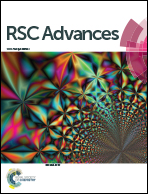CuFe2O4@PDA magnetic nanomaterials with a core–shell structure: synthesis and catalytic application in the degradation of methylene blue in water†
Abstract
In this paper, core–shell polydopamine (PDA)-encapsulated CuFe2O4 (CuFe2O4@PDA) magnetic nanoparticles (MNPs) were synthesized through in situ self-polymerization for the first time. The size of the core–shell product can be controlled by tuning the dopamine monomer concentration. The formation of a PDA layer effectively enhanced the catalytic performance and provided a large specific surface area which offered more active sites for the effective interaction. The as-synthesized CuFe2O4@PDA MNPs were characterized and their catalytic activity was evaluated using the degradation of methylene blue (MB) in the presence of H2O2 as a model reaction. The experimental results showed that MB could be degraded efficiently using CuFe2O4@PDA MNPs as a catalyst. Under the optimized conditions, the degradation efficiency of MB was above 97%. Furthermore, a possible reaction mechanism was discussed. Finally, the catalyst was used for effective degradation of MB in a Yellow River water sample, which indicates its potential for practical applications in water pollutant removal and environmental remediation.


 Please wait while we load your content...
Please wait while we load your content...